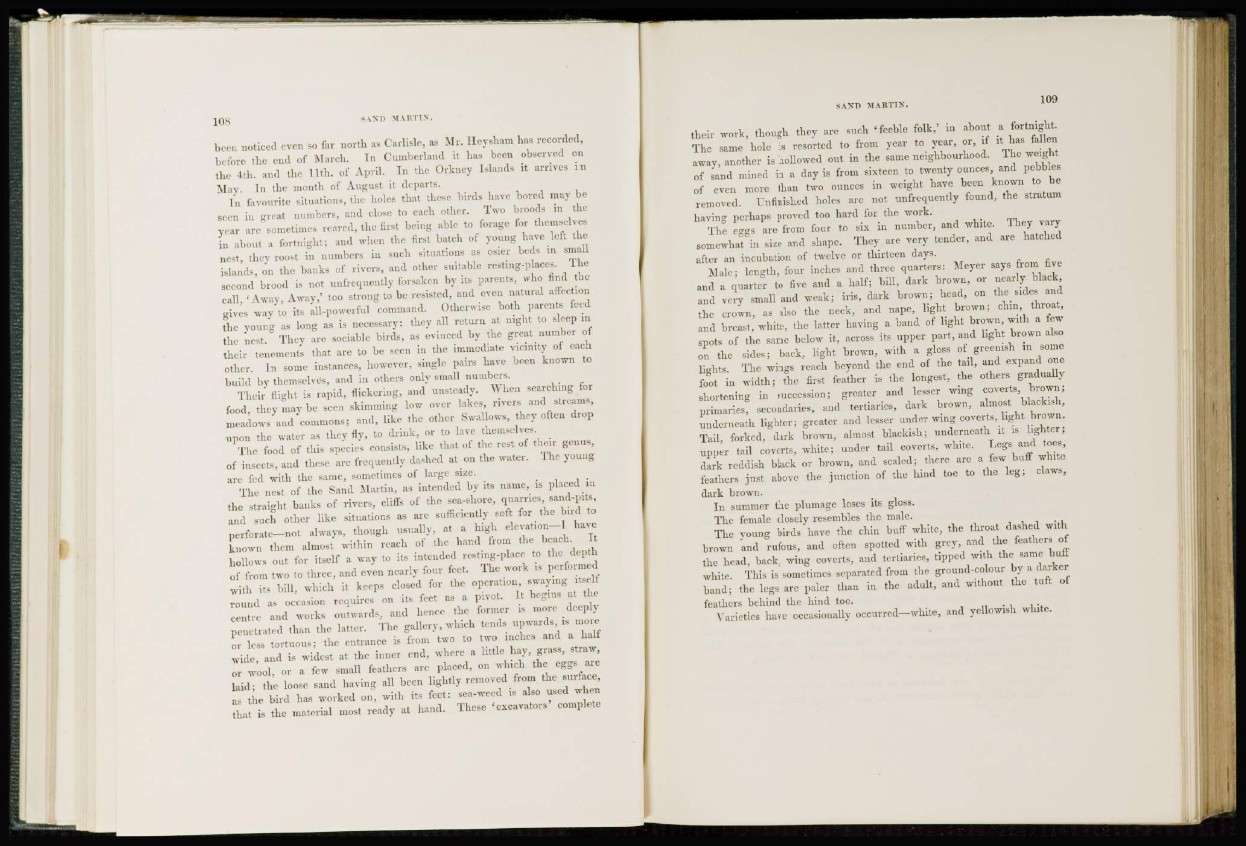
I OS S A S D MARTIN.
been noticed even so far north as Carlisle, as Mr. Heysham has recorded,
before the end of March. In Cumberland it has been observed on
the 4th. and the 11th. of April. In the Orkney Islands it arrives in
May. In the month of August it departa.
In favourite situations, the holes that these birds have bored may be
seen in great numbers, and close to each other. Two broods in the
year are sometimes reared, the first being able to forage for themselves
in about a fortnight; and when the first butch of young have left the
nest, they roost in numbers in such situations as osier beds in small
islands, on the banks of rivers, and other suitable resting-places. The
second brood is not uufrcquently forsaken by its parents, who find the
call, 'Away, Away,' too strong to be resisted, aud even natural affection
gives way to its all-powerful command. Otherwise both parents feed
the young as long as is necessary: they all return at night to sleep in
the nest. They are sociable birds, as evinced by the great number of
their tenements that are to be seen in the immediate vicinity of each
other. In some instances, however, single pairs have been known to
build by themselves, and in others only small numbers.
Their flight is rapid, flickering, and unsteady. When searching for
food, they may be seen skimming low over lakes, rivers and streams,
meadows and commons; and, like the other Swallows, thev often drop
upon the water as they fly, to drink, or to lave themselves.
The food of this species consists, like that of the rest of their genus,
of insects, and these are frequently dashed at on the water. The young
are fed with the same, sometimes of large size.
The nest of the Sand Martin, as intended by its name, is placed in
the straight banks of rivers, cliffs of the sea-shore, quarries, sand-pits,
and such other like situations as are sufficiently soft for the bird to
perforate—-not always, though usually, at a high elevation—I have
known them almost within reach of the hand from the beach. It
hollows out for itself a way to its intended resting-place to the depth
of from two to three, and even nearly four fect. The work is performed
with its bill, which it keeps closed for the operation, swaying itself
round as occasion requires on its feet as a pivot. It begins at the
centre and works outwards, and hence the former is more deeply
penctrated than the latter. The gallery, which tends upwards, is more
or less tortuous; the entrance is from two to two inches and a half
wide, and is widest at the inner end, where a little hay, grass, straw,
or wool, or a few small feathers are placed, on which the eggs are
laid; the loose sand having all been lightly removed from the surface,
as the bird has worked on, with its fect: sea-weed is also used when
that is the material most ready at hand. These 'excavators* complete
their work, though they are such 'feeble folk,' in about a fortnight.
The same hole is resorted to from year to year, or, if it has fallen
away, another is hollowed out in the same neighbourhood. The weight
of sand mined in a day is from sixteen to twenty ounces, and pebbles
of even more than two ounces in weight have been known to be
removed. Unfinished holes arc not unfrequently found, the stratum
having perhaps proved too hard for the work.
The eggs are from four to six in number, and white. They vary
somewhat in size and shape. They are very tender, and are hatched
after an incubation of twelve or thirteen days.
Male; length, four inches and three quarters: Meyer says from five
and a quarter to five and a half; hill, dark brown, or nearly black,
and very small and weak; iris, dark brown; head, on the sides and
the crown, as also the neck, and nape, light brown; chin, throat,
and breast, white, the latter having a band of light brown, with a few
spots of the same below it, across its upper part, and light brown also
on the sides; back, light brown, with a gloss of greenish in some
lights. The wings reach beyond the end of the tail, and expand one
foot in width; the first feather is the longest, the others gradually
shortening in succession; greater and lesser wing coverts, brown;
primaries, secondaries, and tertiarics, dark brown, almost blackish,
underneath lighter; greater and lesser under wing coverts, light brown.
Tail, forked, dark brown, almost blackish; underneath it is lighter;
upper tail coverts, white; under tail coverts, white. Tegs and toes,
dark reddish black or brown, and scaled; there are a few buff white
feathers just above the junction of the hind toe to the leg; claws,
dark brown.
In summer the plumage loses its gloss.
The female closely resembles the male.
The young birds have the chin buff white, the throat dashed with
brown and rufous, and often spotted with grey, and the feathers of
the head, back, wing coverts, and tertiaries, tipped with the same buff
white. This is sometimes separated from the ground-colour by a darker
band; the legs are paler than in the adult, and without the tuft of
feathers behind the hind toe.
Varieties have occasionally occurred—white, and yellowish white.